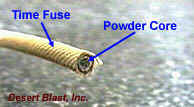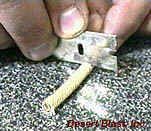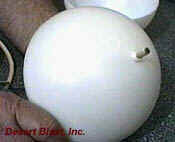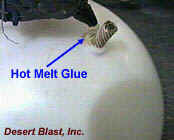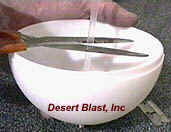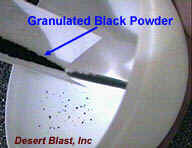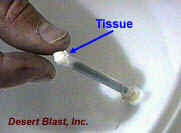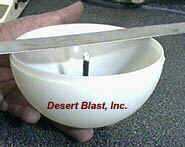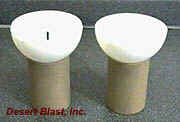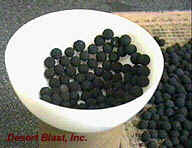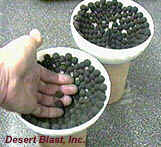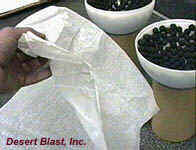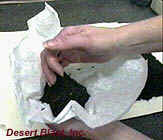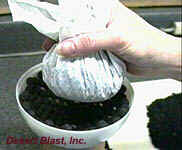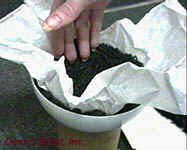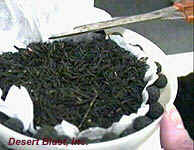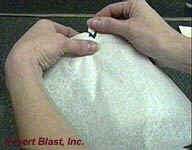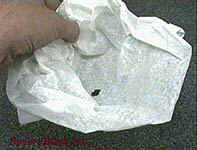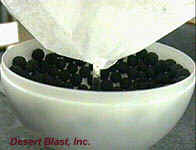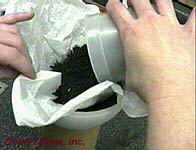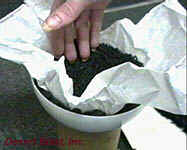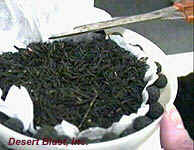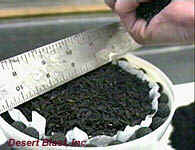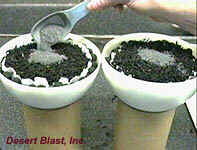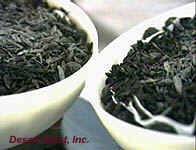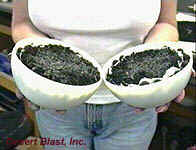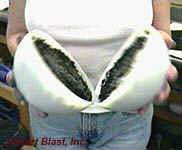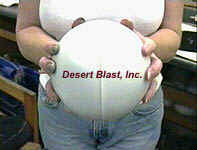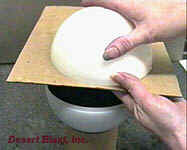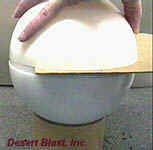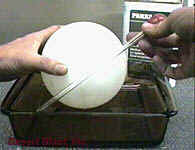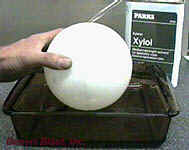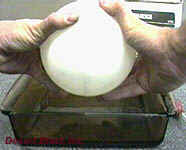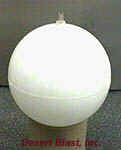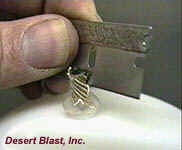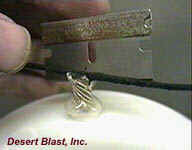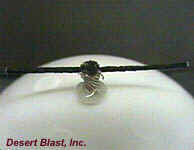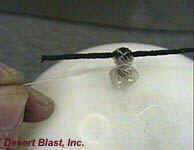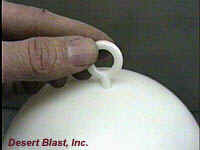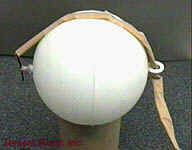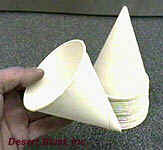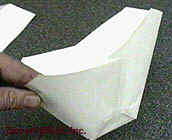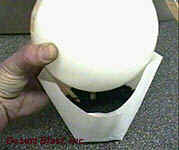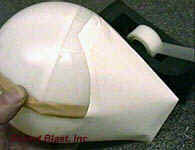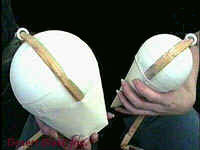AERIAL SHELLS
The following is the procedure that has been used to assemble aerial shells for many years. Aerial shells are launched from a mortar (a specialized cardboard or HDPE plastic pipe), sending the shell high into the air with its time delay fuse lit. When the shell reaches its maximum altitude, it explodes, igniting the colored stars inside and throwing them a great distance.
Like all fireworks, these are by no means safe to manufacture and doing so is illegal in the United States unless you are licensed by the BATF. An assembled aerial shell "going off" on the ground in front of you (instead of hundreds of feet in the air) will most likely kill you or leave you disfigured for life. These directions will work for 4" through 8" shells, the sizes most commonly used by shell makers. We show the assembly of a 6" shell because it's a little easier to work with and photograph. Shells smaller than 4" generally can be assembled in a simpler fashion and shells larger then 8" (which we're not going to cover at all) get a lot more complicated.
To save time and trouble, most people pretty much stick with using plastic shell casings (as opposed to paper). Although these directions will apply to any size, the most common are 4", 6", and 8". One thing to do before assembling a plastic shell is to make sure the 2 halves fit together without effort. This may sound strange, but we've run into several bad casings that just don't fit together (and it can be quite aggravating to find this out after you've spent time loading your shell).
PART ONE: FUSING
| The time-delay fuse used in aerial shells is known as 1/4" Time Fuse or Oriental Time Fuse. It is available in coils of different lengths and has a nominal outer diameter of 1/4" (although occasionally you will see other diameters for sale; stick with the 1/4") . All 4", 6" & 8" shells use the same length of fuse: 1 1/4". |
It is important that time fuse is cut with a blade (we recommend a Fuse Cutter) and not a scissor-type device. The powder core is somewhat fragile and if cut with a scissors or similar device the end is crushed (to varying degrees) and the powder loosened from its packed state, increasing its burn rate. | |
Insert a 1 1/4" long fuse into the bottom half of the shell, leaving about half the length sticking out of the bottom of the shell. | |
Using a Hot Glue Gun, lay an even bead of glue around the base of the fuse, sealing it to the casing. When cool, do the same on the inside of the shell. It is important that there be no gaps in the glue which could allow fire to enter the shell during launch. | |
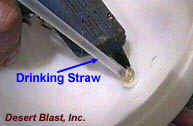 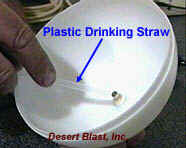 | Slip a plastic drinking straw over the fuse end on the inside of the shell and glue into place. There are some straws that are either too small or too large to fit over time fuse; these are, unfortunately, usually the "free" ones you'll find at your favorite fast food restaurant. What will fit are the "Flexi-Straws" found in just about every supermarket. They come in boxes of 100 and are very inexpensive. |
Cut the straw off so it's just under the rim of the shell. | |
| Fill the straw to within 1/4" of the top with granulated black powder. We use granulated homemade black powder. Its manufacture is described in the Black Powder Manufacture section. Commercial 3FG or similar may also be used. |
| Roll up a small ball of tissue and push it into the end of the straw with a nail or pencil. It shouldn't be too tight, just tight enough to hold the powder in and not fall out when the shell is turned over. Lay a ruler across the rim to make sure that the fuse tube does not protrude over the edge. If it does, just clip it shorter. |
PART TWO: LOADING
| Now that your shell is properly fused, it is ready to load with stars and a break charge. For ease of assembly (and to protect the fuse protruding from bottom half), set the two hemispheres on cardboard tubes or cups. |
Starting with the top half (the one without the fuse), begin loading stars into the shell. Spread them one layer deep all around the inside of the hemisphere. | |
Continue loading until both halves of the shell have a layer of stars along the inside. Do not load the stars all the way up to the rim. There is a small lip on shell halves that must fit together, so leave a space of about 1/4" from the rim on both halves. | |
Next, you will need some tissue paper, the kind that you wrap fragile items in or pack Christmas presents with. You can certainly use other types of thin paper, even a 1-ply paper towel, but tissue paper is thin, strong, and easily obtainable. | |
The next thing you'll need are some Meal Coated Rice Hulls (info on making them can be found in our BP Coated Corn Cob & Rice Hulls section). Cut a piece of tissue paper about 12" square, form it into a little cup, and dump a heaping handful of coated rice hulls into it. | |
| Hold the package of hulls by the top and drop it into the shell, quickly spreading the hulls up against the wall of stars. The rice hulls pressing on the stars will prevent them from falling in. The tissue paper merely prevents the stars from migrating into the center of the shell during transport or launch. |
| Trim the tissue paper so that it's under the lip of the shell casing. Add or remove some rice hulls until the shell is full to about 1/8" from the top. Check with a straight edge and be careful not to overfill, as this will make it difficult to assemble the shell. Set this half of the shell aside when complete. |
| Loading the fused side of the shell with hulls is a tad more difficult... Cut another 12" square of tissue paper and tear a small 1/2" diameter hole in the center. Form it into a little cup with the hole at the bottom. |
| Now gently slide the paper cup over the straw and let it rest in the shell. If you bump the shell, your stars will go tumbling to the bottom, so be careful. |
| Get a cupful of coated rice hulls and all at once, dump the entire cupful into the shell. Do not do this slowly; the stars will fall in. If you just dump it in all at once, the hulls will hold the stars in place before they've got a chance to fall. Spread the hulls around evenly. |
| Trim the tissue paper all around the shell and make sure that it doesn't extend above the rim. |
| Do the same as you did on the other shell half, adding or removing hulls until the shell is full to just about an 1/8" under the rim. |
PART THREE: FINISHING & CLOSING
| Dump half a tablespoon of Whistle Mix in each shell hemisphere. The formula for whistle mix and can be found in the Making Fireworks & Chemical Experiments section. Some pros like to use flash powder (as shown in the images), but stick with whistle mix. Flash powder frequently breaks the shell too hard, smashing the stars into dust, or shoots them out so fast that they blow out. You'll find that whistle mix works perfectly almost all the time. |
| The shell is now ready to be closed. There are two ways to do this. You can simply snap the two halves together (as we do) or you can hold a piece of thin cardboard over one half. We'll show you both ways: |
| The quick way is to line up the two shell halves. One has a lip that fits inside the other. Rest the opposing shell on the lip and tilt them a little toward each other. With one fast move, snap the shell together. I know, it looks like everything will go flying, but every person who we've taught to do it, does it with ease. If you feel you lack the coordination to accomplish this daring maneuver, try the alternate method: |
| Place a thin piece of cardboard (like the kind you find on the back of note pads) on one half of the shell. Holding it in place, flip the shell over and lay it on the bottom half. Align the two halves, and slowly pull out the cardboard, snapping the two hemispheres together. |
| The shell is now ready to be sealed (you'll need a glass or metal container to catch the excess solvent that will drip off). Pull the shell just a hair apart (not too much, just a hair) and using either Xylol or Methylene Chloride in an eye dropper (squirt bottle, or similar), run the solvent around the seam of the shell. Rotate the shell so there are no dry gaps. Capillary attraction will draw the solvent into the seam and melt the plastic shell lips together. Before the solvent dries, push the shell halves firmly together, making sure that the shell is perfectly sealed. |
| Support the shell and orient it so the time fuse is pointing up. The next steps will be the final fusing of the shell and attachment of the lift charge. |
PART FOUR: FINAL FUSING & LIFT CHARGE
| Using a razor blade, slice the time fuse in half to a depth of about 1/4" | ||||||||||||
| You'll need some Black Match, also known as "Crossmatch" (black powder coated cotton string) for the next step. You can see how that is made in our Blackmatch and Quickmatch section. Rock the blade back and forth to open up the time fuse and insert a 3" long piece of crossmatch. Push the crossmatch in so it's level with the top of the time fuse. | ||||||||||||
| Using some good quality thread (or better yet, dental floss), wrap a few turns around the time fuse and the crossmatch, securing them together. Tape the loose ends of the thread to the shell casing. | ||||||||||||
| Flip the shell over, dip the fuse ring (that came with your shell casing) in some solvent and insert it in the top hole. The fuse ring will support the shell as it is loaded into the mortar. | ||||||||||||
| Lay the shell on its side and run a 4 foot length (approximately) of quickmatch through the fuse ring and around the shell, ending at the time fuse. The quickmatch doesn't have to actually touch the crossmatched time fuse. They will both be inside a pouch of lift powder (granulated black powder) and will ignite simultaneously. Tape the quickmatch to the shell casing every few inches so it is secure. The quickmatch needs to be about 18" longer than the mortar you will be using to fire your shells. | ||||||||||||
The final step is to add a pouch filled with lift powder (coarse granulated black powder). We use homemade lift powder, although commercial FFG or FFFG Black Powder can be used. If commercial black powder is used, the amount of lift charge is cut just about in half due to its faster burning speed. Directions for making Lift Powder can be found here. Lift charges are as follows:
| |||||||||||||
| A small pouch must be attached to the bottom of the shell to hold the lift charge. For the smaller 4" shells, "Solo" cone-shaped paper cups can be used. They're cheap and easily obtainable. Regular "Dixie" paper cups cannot be used because they're coated with wax, making it difficult to attach them to the shell. | ||||||||||||
| Larger shells require that you fashion a pouch out of paper. A single sheet triangularly folded with the ends trimmed and taped makes an excellent pouch. Of course, any design can be used just as long as it can be attached to the shell and it doesn't leak out the lift powder inside. The pouch is filled with the appropriate amount of lift powder and then securely taped to the bottom of the shell. | ||||||||||||
| Completed aerial shells (6" shell and 4" shell). | ||||||||||||
Always remember to tear off 12 to 18 inches of paper off the end of the quickmatch fuse for delay before launching. As stated before, aerial shells are complex and dangerous fireworks. Although this description of the assembly procedure is complete, many of the potential problems and warnings have not been addressed. Never attempt the construction of these devices unless you are licensed and have been properly trained to do so.

